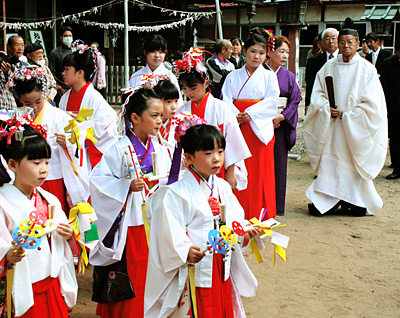- HOME
- Festival and Rituals
What is SHINTO?

Festivals (Matsuri) are offered in thanks to the deities for their bounty. An incredible number of festivals are conducted by each Shinto shrine throughout the year.
Large festivals, in particular, are held at the turning points between seasons. All of the seasonal changes are related to rice farming, since rice cultivation is one of the most important traditional livelihoods for the Japanese.
In the spring festival, people pray for rich and bountiful harvest. In the autumn, villagers thank the deity for providing the season’s crops. In the hot humid season of summer festivals, community prayers go towards driving away disasters and misfortune. At the winter festivals, they pray for the revival of life and rich harvest for the coming spring.
There are significant offerings for the deity at these festivals such as food offerings and traditional court music and dance. People offer premium rice, sake, water, salt, seasonal vegetables, seasonal fruits, meats and fish for the deity. After the offering, people share these foods in order to gain spiritual strength from the deity.
What do the Japanese specifically pray for at these rituals? It is to wish for a simple and peaceful life for all people.
Shinto festivals are not only limited to shrines but are also conducted by families. People set up altars in the center of their homes. This is the spiritual residence of their ancestors, to which they give thanks for daily life and pray for peace.
Respecting deities and cherishing ancestors have been important aspects of faith for the Japanese. These are household beliefs inherited from ancient times and practiced up until the present day.
Here are some typical examples of Japanese household festivals and rituals.
January 1st
New Year’s Day is a day to welcome deities at home with offerings and entertain them with special delicacies. All members of the family gather, and celebrate like Christmas Day in western countries. It is believed that on New Year’s Day the spirit of the deities fills the household.
February 3rd
Setsubun is a bean throwing festival held to drive off evil spirits. Families shout “oni wa soto” (get out demons) and “fuku wa uchi” (happiness come in) when they throw the beans. The next day of Setsubun is Risshun, which means the first day of spring, and is thought to be the beginning of the year according to the lunar calendar.
March 3rd
Hinamatsuri, the Japanese Doll Festival, originated from ancient times and is considered to be a festival for young girls to ward off evils. Families decorate platforms with a red carpet to display ”Hina Dolls”, a group of ornamental dolls clad in traditional court dress from the Heian period. Peach flowers and rice cakes also accompany this display.
May 5th
The Tango Festival takes place on Children’s Day (Kodomo no Hi) and is a festival for young boys. Families with boys decorate homes by raising huge windsocks in the shapes of carp, miniature samurai armors and warrior dolls, in prayer for their children’s healthy growth.
June 30th
Nagoshi-no-Oharae, the Major Purification Ritual of the summer, is held at the mid-point of the year. The Japanese conduct purification ceremonies to rid themselves of sin and impurity.
August 13-16th
Obon, the Festival for the Ancestors is one of the two most vitally important rituals of the Japanese year, together with the New Year celebrations. Families welcome the ancestral spirits, entertain and delight them, and bid them farewell until the following year. Depending on the region in Japan, it is held either from July 13 to 16 or from August 13 to 16.
November 15th
Shichi-Go-San, Seven-Five-Three Celebration, is an event for children. Girls at their third and seventh year and boys at their fifth year are dressed in kimonos and visit shrines to receive divine blessing and pray for healthy growth.
December 31st
O’harae, the Grand Purification ritual, is held on the final day of the year. People purify themselves for the removal of all sin, impurity and misfortune so that they can have a fresh start to the New Year.
A variety of seasonal festivals and rituals are also held in many different areas of Japan, symbolizing the Japanese mindset as well as the wisdom of their ancestors.
- HOME
- What is SHINTO?